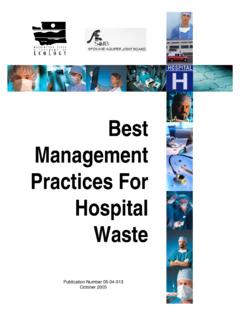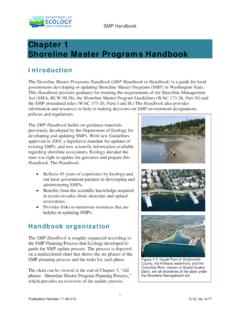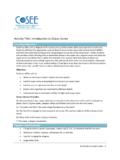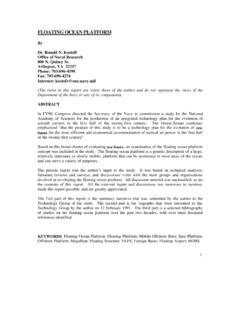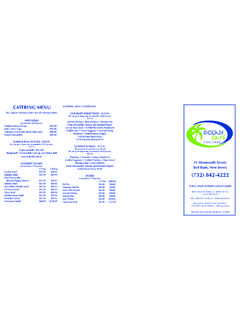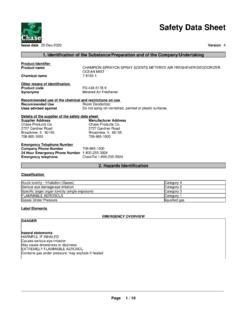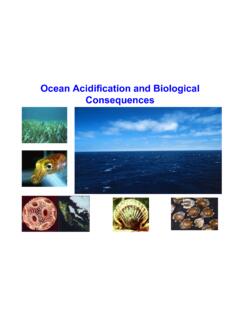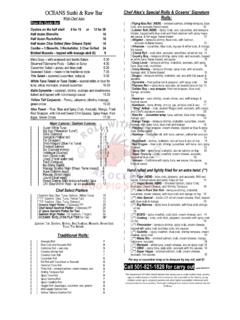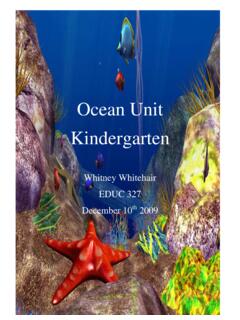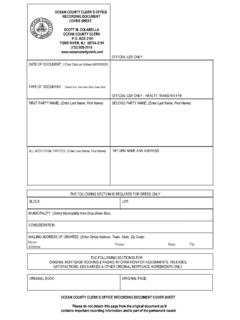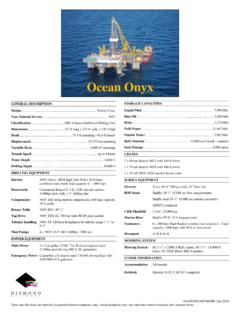Transcription of Ocean Acidification - from Knowledge to Action
1 Washington State Blue Ribbon Panel on Ocean Acidification Ocean Acidification : From Knowledge to Action Washington State's Strategic Response November 2012. Washington State Blue Ribbon Panel on Ocean Acidification Co-Chairs William D. Ruckelshaus Jay J. Manning Madrona Venture Group Cascadia Law Group Panel Members Lisa Ayers, Pacific County Dennis J. McLerran,* EPA Region 10. Commission Edward Miles, University of The Honorable Brian Blake, Washington Climate Impacts Group . Washington State House of Representatives Jan Newton, University of Washington Applied Physics Laboratory Steven Bloomfield, Mason County . Commission Betsy Peabody, Pacific Shellfish Institute and Puget Sound Restoration Shallin Busch, NOAA Northwest Fund . Fisheries Science Center The Honorable K evin R anker, Chris Davis, The Nature Conservancy Washington State Senate Bill Dewey, Taylor Shellfish Company Jennifer Ruesink, University of Washington Department of Biology The Honorable Norm Dicks.
2 House of Representatives Ron Sims, Puget Sound Partnership Richard A. Feely, NOAA Pacific The Honorable Norma Smith, . Marine Environmental Laboratory . Washington State House of Representatives Carolyn Friedman, University of . Washington School of Aquatic & Ted Sturdevant, Washington Fishery Sciences Department of Ecology The Honorable Peter Goldmark, The Honorable Dan Swecker, . Washington Department of Natural Washington State Senate Resources George Waldbusser, Oregon Sara K endall, Weyerhaeuser State University, College of Ocean &.. Company Atmospheric Sciences Terrie K linger, University of Brad Warren, Sustainable Fisheries . Washington School of Marine & Partnership Environmental Affairs Terry Williams, Tulalip Tribes The Honorable Micah McCarty, . Makah Tribe * Represented by Kate Kelly, EPA.
3 Region 10. Acknowledgments Project Team Hedia Adelsman, Washington Department of Ecology . Lara Whitely Binder, University of Washington Climate Impacts Group . Meg Chadsey, Washington Sea Grant . Contributors We thank the many authors and contributors for their extensive work in the development of this report. Special thanks goes to members of the work groups who developed the recommendations (see Appendix 2 for the list of participants). Funding Entities We also want to thank the following funding entities for their support of the Washington State Blue Ribbon Panel's work: National Oceanic and Atmospheric Administration Rockefeller Brothers Funds Stanford University Center for Ocean Solutions Sustainable Fisheries Partnership The Bullitt Foundation The Ocean Conservancy Environmental Protection Agency University of Washington Climate Impacts Group University of Washington College of the Environment Washington Department of Ecology Washington Department of Natural Resources Washington Sea Grant Editing and Production Sandra Bigley, NOAA Pacific Marine Environmental Laboratory Tonya Clayton, Aqueous Media, LLC.
4 Bonnie DeJoseph, Washington Sea Grant Photographs were provided by a number of individuals and entities. See Photo Credits in Appendix 5 for more information. Publication and Contact Information This report is available on the Washington Department of Ecology's website at For more information contact: Executive Office Washington Department of Ecology Box 47600. Olympia, WA 98504-7600. Phone: 360-407-7000. Recommended citation format: Washington State Blue Ribbon Panel on Ocean Acidification (2012): Ocean Acidification : . From Knowledge to Action , Washington State's Strategic Response. H. Adelsman and L. Whitely Binder (eds). Washington Department of Ecology, Olympia, Washington. Publication no. 12-01-015. For a technical summary of Ocean Acidification in Washington, see: Feely, , T.
5 Klinger, Newton, and M. Chadsey (2012): Scientific Summary of . Ocean Acidification in Washington State Marine Waters. NOAA OAR Special Report. This technical summary is available on the Washington Department of Ecology's website at: Accessibility options: If you need this document in a format for the visually impaired, call the Executive Office at 360-407-7000. Persons with hearing loss, call 711 for Washington Relay Service. Persons with a speech disability, call 877-833-6341. Contents Summary ix What is Ocean Acidification ? xi Why Does Washington Need to Act on Ocean Acidification ? xii Ocean Acidification : From Knowledge to Action xvi A Time to Act xix 1. Introduction 1. 2. Ocean Acidification in Washington State Marine Waters 7. Ocean Acidification : Causes and Trends 9. Local Ocean Acidification : Contributing Processes and Regional Distinctions 11.
6 Species Responses to Ocean Acidification 16. Ecosystem Responses to Ocean Acidification 21. Summary 23. 3. Responding to Ocean Acidification 25. 4. Reduce Emissions of Carbon Dioxide 33. Strategy Take Action to reduce global, national, and local emissions of carbon dioxide. 37. 5. Reduce Local Land-Based Contributions to Ocean Acidification 41. Strategy Strengthen and augment existing pollutant reduction actions to reduce nutrients and organic carbon. 46. Strategy Impose stringent controls to reduce and limit nutrients and organic carbon from sources that are contributing significantly to Acidification of Washington's marine waters. 50. 6. Increase Our Ability to Adapt to and Remediate the Impacts of Ocean Acidification 53. Strategy Remediate seawater chemistry. 56. Strategy Increase the capacity of resource managers and the shellfish industry to adapt to Ocean Acidification .
7 58. Strategy Enhance resilience of native and cultivated shellfish populations and ecosystems on which they depend. 61. 7. Invest in Washington's Ability to Monitor and Investigate the Causes and Effects of Ocean Acidification 65. Strategy Understand the status and trends of Ocean Acidification in Washington's marine waters. 68. Strategy - Identify factors that contribute to Ocean Acidification in Washington waters, and estimate the relative contribution of each. 72. Strategy - Characterize biological responses of local species to Ocean Acidification and associated stressors. 74. Strategy Build capabilities for short-term forecasting and long-term prediction of Ocean Acidification . 76. 8. Inform, Educate and Engage Stakeholders, the Public, and Decision Makers in Addressing Ocean Acidification 79.
8 Strategy Share information showing that Ocean Acidification is a real and recognized problem in Washington State. 81. Strategy Increase Ocean Acidification literacy. 84. 9. Maintain a Sustainable and Coordinated Focus on Ocean Acidification 87. Strategy - Ensure effective and efficient multi-agency coordination and collaboration. 89. 10. Conclusions 93. Appendices 97. Appendix 1. Summary Table of Panel Recommendations 99. Appendix 2. Blue Ribbon Panel Workgroup 111. Appendix 3: Examples of Ocean Governance Structures 115. Appendix 4. Acronyms and Glossary 119. Appendix 5. Photo Credits 127. Appendix 6. Letter from Rep. Norma Smith, Panel member, to the co-chairs 131. Summary What is Ocean Acidification ? B etween 2005 and 2009, disastrous production failures at Pacific Northwest oyster hatcheries signaled a shift in Ocean chemistry that has profound implications for Washington's marine environment.
9 Billions of oyster larvae were dying at the hatcheries, which raise young oysters in seawater. Research soon revealed the cause: the arrival of low-pH seawater along the West Coast, which created conditions corrosive to shell-forming organisms like young oysters. The problem, in short, was Ocean Acidification . What is Ocean Acidification ? Ocean Acidification is a reduction in the pH1 of seawater for an extended period of time due primarily to the uptake of carbon dioxide from the atmosphere by the Ocean . Local sources of Acidification such as nitrogen oxides and sulfur oxide gases, or nutrients and organic carbon from wastewater discharges and runoff from land-based activities, can also contribute to Ocean Acidification in marine waters. Since the beginning of the industrial era more than 250 years ago, the rapid growth in fossil fuel burning (for example, coal and oil) and land use changes have caused a dramatic rise in carbon dioxide emissions.
10 About one-quarter of these human-generated emissions have been absorbed by the oceans. Through a well-understood series of chemical reactions, carbon dioxide gas has an acidifying effect when dissolved in seawater. As a result, the average acidity (as measured by the hydrogen ion concentration) of the surface Ocean has increased about 30 percent since 1750. Today's Ocean Acidification is important not only for the amount of change that has occurred thus far but also for how quickly it is happening. The current rate of acidifi- cation is nearly ten times faster than any time in the past 50 million years, outpacing the Ocean 's capacity to restore oceanic pH and carbonate chemistry. The rapid pace of change also gives marine organisms, marine ecosystems, and humans less time to adapt, evolve, or otherwise adjust to the changing circumstances.



